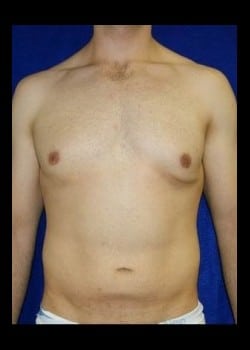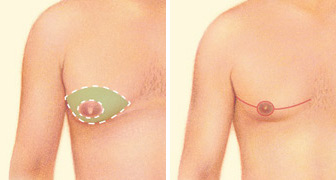Bilateral gynecomastia
Individual results may vary.
Case ID: 2280This 29 year old male patient came to Dr. Medalie at his Cleveland Beechwood office desiring male breast reduction. He was very fit but had always had tissue under the nipples since he was an adolescent. Dr. Medalie took him to University Suburban Health Surgery Center on Cleveland’s east side to perform ultrasonic liposuction and sub-areolar resection of glandular breast tissue as an outpatient. The patient is shown 3 months after the surgery and is very pleased with his flattened chest.
*Plastic Surgery results can vary from patient to patient and are not guaranteed
What is gynecomastia surgery?
Gynecomastia surgery reduces breast size in men, flattening and enhancing the chest contours.
In severe cases of gynecomastia, the weight of excess breast tissue may cause the breasts to sag and stretch the areola (the dark skin surrounding the nipple). In these cases the position and size of the areola can be surgically improved and excess skin may be reduced.
Plastic surgery to correct gynecomastia is technically called reduction mammaplasty.
What is gynecomastia?
Gynecomastia is a condition of overdeveloped or enlarged breasts in men that can occur at any age. The condition can be the result of hormonal changes, heredity, obesity or the use of certain drugs.
Gynecomastia can cause emotional discomfort and impair your self-confidence. Some men may even avoid certain physical activities and intimacy simply to hide their condition.
Gynecomastia is characterized by:
- Excess localized fat
- Excess glandular tissue development
- Sometimes excess breast skin
- Presence unilaterally (one breast) or bilaterally (both breasts)
What are the steps of a gynecomastia procedure?
A gynecomastia procedure includes the following steps:
Anesthesia
Medications are administered for your comfort during the surgical procedures. The options include intravenous sedation and general anesthesia. Your doctor will recommend the best option for you.
Liposuction technique
In cases where gynecomastia is primarily the result of excess fatty tissue, liposuction techniques alone may be used. This requires insertion of a cannula, a thin hollow tube, through several small incisions.
The cannula is moved back and forth in a controlled motion to loosen the excess fat, which is then removed from the body by vacuum suction.
There are various liposuction techniques that may be used; the technique most appropriate in your case will be defined prior to your procedure.
Excision technique
Excision techniques are recommended where glandular breast tissue or excess skin must be removed to correct gynecomastia. Excision also is necessary if the areola will be reduced or the nipple will be repositioned to a more natural male contour. Incision patterns vary depending on the specific conditions and surgical preference.
Combination of liposuction & excision techniques
Sometimes gynecomastia is treated with both liposuction and excision.






